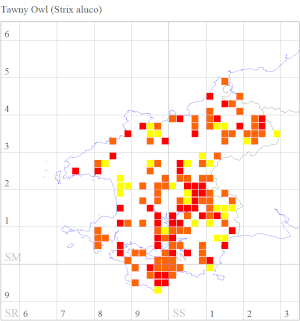Examination of the tetrad map suggests that the Tawny Owl breeding population distribution has thinned out in places over the last 20 years, especially across the more intensively farmed landscape with smaller amounts of woodland in the south of the county. However, there was evidence of higher tetrad occupancy in the east, and also on the St David’s peninsula where they were absent in the 1984-88 atlas period.
Overall there was a 21% decline in the number of tetrads in which they were found. The number of tetrads where presence only was recorded was down by 50% but the number of tetrads where probable and confirmed breeding was recorded was probably not significantly different between the two atlas periods.
The population stronghold currently appears to be in the more wooded Eastern Cleddau area and tributary valleys. There is a reasonably strong presence in the Gwaun and Cych valleys and also near the town of Pembroke. These apparent changes in distribution need to be treated with some caution. Being mainly nocturnal, they are a difficult species to record and so their distribution may be affected by observer effort bias. Added to the problem is the fact that both males and females will call from different parts of their territory and this could inflate the population estimate.
Donovan and Rees (1994) postulated that there were 4 – 5 pairs of Tawny Owls per occupied tetrad in Pembrokeshire during the 1984-88 atlas period. This produced an estimate of between 800 and 1,000 pairs across the county.
Observations of two areas, based on calling birds heard within 3 tetrads in woodland at Stackpole and within 2 tetrads at Pickle Wood and Minwear, were made during the 2003-07 period by Haycock, (unpublished data). This suggested a maximum breeding density in both areas of two and three pairs per tetrad respectively, about half the estimated total for the earlier period. Both these areas contain what is considered to be optimal breeding and feeding habitat.
1988-91 National Atlas notes the difficulties in estimating the population of this species due to their nocturnal behaviour. They suggest an average density of 10 pairs in each occupied 10-km square for Britain as a whole, based on 1988-91 National Atlas data and a national Tawny Owl survey (Percival, 1990). This provided a lower estimated population for Britain than previous national population estimates but was considered to be the best available at that time. However, it was based mainly on a single year national Tawny Owl survey when small mammal populations were low.
If two or three pairs per tetrad, from a small sample of only five tetrads, is typical of other tetrad densities where they were recorded in 2003-07, then this would provide a Pembrokeshire-wide estimate of between about 320 and 470 pairs.
Whether there has been a considerable reduction in the Tawny Owl breeding population is difficult to determine, for reasons given earlier. An apparent slight distribution increase in the east of the Vice-County may also reflect better recording effort in this area, and so may not represent a real shift. More survey work is required to determine if the 21% decline in the number of tetrads supporting Tawny Owls equates to a real population decline or just re-emphasises difficulties in recording this species.
Bob Haycock

Fieldwork 2003-07 (based on 490 tetrads)
Red = breeding confirmed = 50
Orange = breeding probable = 79
Yellow = breeding possible = 30
Total tetrads in which registered = 159 (32.5%)
 Tuesday, August 27, 2013 at 7:52AM
Tuesday, August 27, 2013 at 7:52AM 





